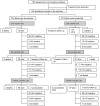Survival of infants born to HIV-positive mothers, by feeding modality, in Rakai, Uganda
- PMID: 19065270
- PMCID: PMC2588542
- DOI: 10.1371/journal.pone.0003877
Survival of infants born to HIV-positive mothers, by feeding modality, in Rakai, Uganda
Abstract
Background: Data comparing survival of formula-fed to breast-fed infants in programmatic settings are limited. We compared mortality and HIV-free of breast and formula-fed infants born to HIV-positive mothers in a program in rural, Rakai District Uganda.
Methodology/principal findings: One hundred eighty two infants born to HIV-positive mothers were followed at one, six and twelve months postpartum. Mothers were given infant-feeding counseling and allowed to make informed choices as to whether to formula-feed or breast-feed. Eligible mothers and infants received antiretroviral therapy (ART) if indicated. Mothers and their newborns received prophylaxis for prevention of mother-to-child HIV transmission (pMTCT) if they were not receiving ART. Infant HIV infection was detected by PCR (Roche Amplicor 1.5) during the follow-up visits. Kaplan Meier time-to-event methods were used to compare mortality and HIV-free survival. The adjusted hazard ratio (Adjusted HR) of infant HIV-free survival was estimated by Cox regression. Seventy-five infants (41%) were formula-fed while 107 (59%) were breast-fed. Exclusive breast-feeding was practiced by only 25% of breast-feeding women at one month postpartum. The cumulative 12-month probability of infant mortality was 18% (95% CI = 11%-29%) among the formula-fed compared to 3% (95% CI = 1%-9%) among the breast-fed infants (unadjusted hazard ratio (HR) = 6.1(95% CI = 1.7-21.4, P-value < 0.01). There were no statistically significant differentials in HIV-free survival by feeding choice (86% in the formula-fed compared to 96% in breast-fed group (Adjusted RH = 2.8[95%CI = 0.67-11.7, P-value = 0.16]
Conclusions/significance: Formula-feeding was associated with a higher risk of infant mortality than breastfeeding in this rural population. Our findings suggest that formula-feeding should be discouraged in similar African settings.
Conflict of interest statement
Figures



References
-
- WHO. Geneva: WHO/UNAIDS; 2006. WHO HIV and Infant Feeding Technical Consultation consensus Statement. Available: http://www.who.int/child_adolescent-_health/documents/pdfs-/who_hiv_infa...: Accessed 2008 April 14.
-
- Coovadia H, Coutsoudis A. HIV, infant feeding, and survival: old wine in new bottles, but brimming with promise. AIDS. 2007;21(14):1837–40. - PubMed
-
- Thior I, Lockman S, Smeaton LM, Shapiro RL, Wester C, et al. Breast-feeding plus infant zidovudine prophylaxis for six months vs. formula feeding plus infant zidovudine for one month to reduce mother-to-child HIV transmission in Botswana: a randomized trial: the Mashi Study. JAMA. 2006;296(7):794–805. - PubMed

